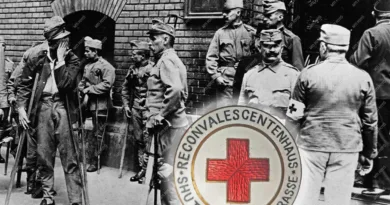Funerals, ceremonies
Giving the ultimate last honor to those who fell in battles was often very difficult or impossible during the Great War. Nevertheless, the Austro-Hungarian troops also tried to accomplish this task. The fallen were brought in from the trenches and from the open fields, if this was possible without further losses. At the same time, this could often not be done not only because of the constant danger to life, but also simply because of a lack of time. The gathering of the wounded and dead was continuous during more silent periods in the fighting. This was done primarily by medical soldiers. If it wasn’t exactly time of an offensive, the removal of daily losses was well organized. Many regimental histories contain accurately prepared records, often by name, those who fell every day.
The dead were buried near the front line. Any place where the artillery fire did not reach was suitable for this purpose. On the Italian front, the stony ground made this work very difficult. In the karst cemeteries were established in depressions behind the front. Dead corpses were buried only temporarily. In the Úz Valley and the surrounding mountains, for example, 5-6 small and large cemeteries have been established in the Eastern Carpathians. Larger cemeteries were opened more distantly, mostly near regiment or division relief sites and field hospitals. Here, those who later died of their wounds and illnesses were laid to rest. A huge number of small cemeteries were liquidated after the war. The dead were exhumed and reburied. In Italy, the remains were collected in the bone chambers of large war memorials.
The funeral ceremony was performed by field priests and pastors at distant burial sites. The all too few pastors could not get to the many cemeteries near the front. There the dead were buried by the commissioned officers of the regiment. Sometimes you can read a notice to relatives with an exact description of the dead grave that the squadron commanders sent to the family. In addition to the funerals, the camp pastors also performed church ceremonies (mass, worship). These occasions may have played an important role in protecting soldiers from the most severe psychological traumas. But some humane commanders may have played a similar role.

In this post, I present the scenes on this topic using the example of the 39th Infantry Regiment. The first image, which also shows the cap badge, shows the main cemetery of the 39s in Lipa of the Karst plateau. The beautifully designed and regularly maintained cemetery showed the grave signs of Protestant soldiers on one side and the grave crosses of Catholics who fell on the other. At that time, even in Debrecen, the different denominations had separate burial places. Lipa fell a little further from the front, where the regiment was withdrawn for reorganization and resting. The cap badge on the picture belongs to the 39s and shows the coat of arms of the city of Debrecen, which is largely the same as of the Hungarian Reformed Church, one of the important centers of which is the city.

The second photo shows a camp mass also in Lipa. I put a religious cap badge on this picture titled Easter on the Doberdo. The larger ecclesiastical feasts were honored by the opposing parties with a mutual ceasefire. At the time, trench fraternization also took place mainly on the Russian front. Either way, the soldiers were more religious than the people today, and that was evident even in the war.

In the third picture, we return again to the main activity of the field priests, the funeral. The picture was taken at the funeral of first lieutenant József Pribil on June 17, 1918. The lieutenant fell during the Monarchy’s Piave offensive on the slopes of Montello as commander of the 1st Machine Gun Squadron of the 39th infantry regiment. So the funeral took place somewhere near the east coast of Piave. Apparently in much more rudimentary conditions than in the Lipa cemetery 1-2 years earlier.





